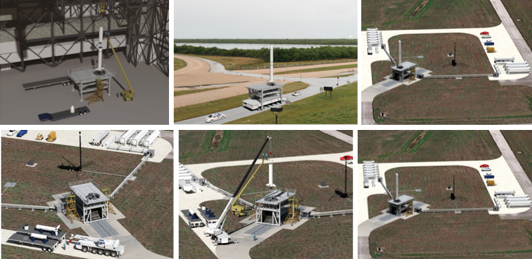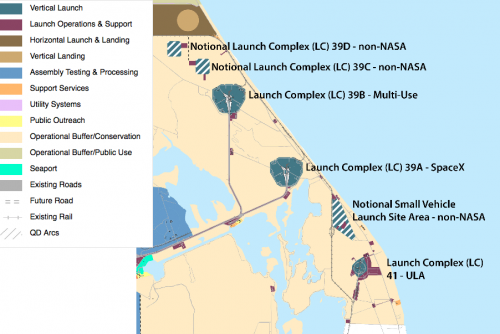
Earlier this week NASA announced plans to build a new launch complex for small class launch vehicles at the agency’s Kennedy Space Center (KSC) in Florida. The new launch pad, Launch Complex-39C (LC-39C), will cater to private businesses looking to develop commercial space capabilities for launching small satellites. This goes hand-in-hand with KSC’s vision of becoming the world’s premier multiuser spaceport, and the development of this new launch complex adds to the versatility of the transforming space center by providing opportunities to ventures and start-up companies in the small satellite industry.
Located at Launch Pad 39B, which is currently undergoing renovation and construction to support launching NASA’s Space Launch System (SLS) rocket, the smaller LC-39C will have the capability to support small class launch vehicles that produce thrust under 200,000 lbs. A significant increase in the development of small satellites, and the lack of capabilities to launch them, recognizes the need for an appropriate launch complex.
Tom Engler, deputy director of Center Planning and Development at KSC, told AmericaSpace that the small class vehicle market was an exciting area for potential commercial space growth.
“This market is being driven through the development of small satellites, mainly in the 3U to 6U range, typically weighing in the 50 to 100 kg range. Due to the significant increase in the desire to develop and launch these small satellites and the lack of capacity in the current launch market, there is significant interest in the development of a small launcher to specifically launch these satellites,” explained Engler.
The development of a small launcher for small class vehicles to launch payloads into low-Earth orbit (LEO) is part of the 21st Century Launch Complex initiative at KSC. It is a mobile system called the Deployable Launch System (DLS) and based on a concept design that NASA describes as a “launch pad in a box.” The supporting ground equipment consists of a launch mount, flame deflector, propellant servicing system, and other basic components necessary for launching small class launch vehicles. The project is managed by the KSC Ground Systems Development and Operations (GSDO) Program and plans on being operational by the end of 2015.

Image Credit: NASA
There are multiple processing concepts that can be supported by the small class vehicle infrastructure at the space center. The small launch vehicle can be vertically processed/integrated in the Vehicle Assembly Building (VAB) and transported to the pad, or vertically integrated at the launch pad.
The Deployable Launch Structure (DLS) will have a total weight capacity of around 130,000 and thrust capability of 200,000 lbs. An umbilical tower will have to be provided by the customer.
According to NASA, the Universal Propellant Servicing System (UPSS) will consist of liquid oxygen (LOX) and liquid methane (LCH4) pressure fed propellant transfer systems with expendable storage volume. The UPSS will also be adaptable to other propellants like liquid hydrogen (LH2), kerosene, and more.
Engler told AmericaSpace that the “overall business for small launch vehicles could grow significantly once they begin flying to low earth orbit.” The capability to launch from KSC will further the development of the small class launch vehicle launch market and bring more growth to the area.
For Glenn Wagner, the opportunity to launch small vehicles from KSC will greatly benefit his start-up business. Wagner is CEO of WAGNER Industries in Orlando and a rapid prototyping engineer. He currently leads a team of young engineers and researchers building small launch vehicles for small payloads. Wagner was motivated to begin his venture company when he realized the complications associated with launching small payloads.
“Current launching costs of small payloads are near $40,000 per kg. Dedicated slots are limited. Secondary slots can be denied on date of launch. Waits average up to three years. Its cause is from a backlog of mini satellites pre-certified for a flight slot, and lack of dedicated launch slots and secondary launch slots to provide for them. The backlog itself is currently at eight years total with many mini satellites needed to be re-certified if they do not launch.”

Image credit: NASA
Wagner has been eyeing locations like Black Rock in Nevada and Cecil Field in Florida for launching his rockets. “Few locations to launch from,” he said. “Kodiak, Mojave, [and] Space Florida offer locations however space is limited to proven vehicles. Blackrock is available to many for ideal testing however distance and location are not ideal for launching. Launching from 39C would enable close proximity launches for our company. Potentially lowering launch costs overall.”
WAGNER Industries caters to a variety of customers in a number of diverse markets. Wagner said his specific customers for launches are those interested in interspatial communications, oceanic and geographic data, and information for humanitarian causes. The Orlando start-up currently has three launch vehicles in development: Konshu 1 (10 kg), Konshu VCLS (60 kg), and Konshu 2 (125 kg).
A map of future vertical launch areas provided in the KSC Master Plan shows various locations for future commercial use. It is important to note that there is a fourth launch complex, 39D, to the upper left of 39C and a vertical landing complex. There is also a “Notional Small Vehicle Launch Site Area” between LC-39A (operated by SpaceX) and LC-41 (operated by United Launch Alliance). AmericaSpace reached out to Engler about whether or not NASA plans on building an additional launch complex in the near future.
“KSC has released an Announcement for Proposals and a separate Notice of Availability that allows for commercial development of vacant land as launch sites and associated processing facilities and part of the implementation of the KSC Master Plan,” said Engler.
NASA recently created an Announcement for Proposals (AFP) for “launch service providers interested in developing vertical launch capabilities on KSC property in accordance with the KSC Master Plan.” Undeveloped land is being offered for commercial purposes to private companies that fit the Vertical Launch requirements. NASA does not expect to benefit from this AFP but instead promote National Space Policy.
According to the Agency Announcement for Proposals for Implementation of the KSC Master Plan, the government objectives for this are:
- Increase commercial access to space
- Enhance U.S. commercial competitiveness in the space launch industry
- Diversify the user base and launch capabilities at KSC
- Promote public-private partnerships to build, expand, modernize, or operate space launch and reentry infrastructure, through launch complex development at KSC
Not only is there a new launch pad for small class launch vehicles undergoing development, but there is land available for potential launching and landing sites as well. Business ventures and start-ups are invited to attend an Industry Day on June 16 to visit the sites and gain a better understanding of the opportunities being made available at KSC. Those interesting in attending Industry Day must fill out a request and have it completed and turned in to the Agreement Officer by 12 p.m. EDT on June 15, 2015.
Be sure to “Like” AmericaSpace on Facebook and follow us on Twitter: @AmericaSpace




Seems like a good thing at first glance. Work with the market and follow the money. Small vehicles with high flight rates could lower costs starting from the bottom and working up.
It does sound a little cart-before-the-horse. There are a number of up and coming potential small launch providers, but designing and building a launcher and fueling system seems a bit much if it’s before they’re ready to contract a launch facility and specify what fuels they will be using. Perhaps there’s more that NASA hasn’t publicized yet in terms of who the potential clients for the pad are.
At second glance, it does seem cart first. Unless there are potential clients closer to ready than we are aware of.
A waste of money…Put it into the SLS and speed it up..Space X will trounce you with these small launchers !!
It will be a waste of money if NASA ends up subsidizing the small launchers. If there is enough revenue, maybe not.
SLS is already overfunded and a little more won’t help. If the money is to be wasted, put it somewhere else.
SpaceX seems to be going large and out of the competition for the smaller loads. If I’m wrong, then you’re probably right.